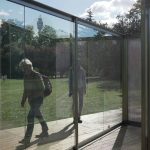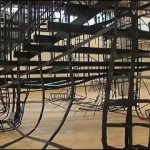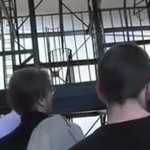Polish artist Monika Sosnowska‘s solo exhibition at Zentrum Paul Klee in Bern, Switzerland, is the first comprehensive exhibition of Sosnowska’s work that has its focus not only on the display of her representative works, but also on Monika Sosnowska’s working process. The show features 18 sculptures from the past ten years, but also 50 models, as well as photographs of the unique process by which her works are made. Monika Sosnowska’s solo exhibition at Zentrum Paul Klee runs until September 10, 2023.
Monika Sosnowska / Zentrum Paul Klee in Bern (Switzerland). Press Preview and introduction by curator Dr. Martin Waldmeier, June 1, 2023.
> Right-click (Mac: ctrl-click) this link to download Quicktime video file.
Monika Sosnowska represented Poland at the 52nd Venice Art Biennale (2007) and had a solo exhibition at Schaulager in Basel, Switzerland, in 2008.
Press text (excerpt):
Monika Sosnowska is one of the best-known artists working today, and one of the most important living artists from Eastern Europe. Since the early 2000s she has developed a characteristic body of sculptural work. Her sculptures – often filling the entire space – and architectural installations made of steel, concrete or other building materials engage with the built environment. She alienates and distorts the works in startling ways.
The exhibition shows 18 sculptures from the past ten years. Sosnowska is making a site-specific work specially for the exhibition in the Zentrum Paul Klee. 50 models, as well as photographs of the unique process by which her works are made provide an insight into the artist’s working method. A selection of photographs by Sosnowska herself reveal her engagement with the urban space and the changes it is undergoing, with a focus on the city of Warsaw.
Inspiration Warsaw: lost stability and empty promises
Monika Sosnowska is an artist who engages intensely with the built environment. Not only with architecture in the narrow sense, but also with the gaps between, which are often overlooked – the urban space in which we move. She grew up in the socialist People’s Republic of Poland and experienced the introduction of democracy there in 1989. She received her training at Poznań Academy of Art under Jarosław Kozłowski, one of the best-known representatives of conceptual art in Poland, as well as at the Rijksakademie van Beeldende Kunsten in Amsterdam. Today the artist lives and works in Warsaw – one of her most important sources of inspiration.
The Polish capital was almost completely destroyed in the Second World War. Its reconstruction as a socialist planned city could not compensate for the losses and empty spaces, but after the end of Stalinism Warsaw enjoyed a heyday of modern architecture in the Bauhaus style. After the political repression of the 1980s and the final change to democracy in 1989, the market economy took over the public space. Many temporary buildings such as bazaars, markets, arcades and shopping centres were constructed. Since then Warsaw has been in a permanent state of change. The urban landscape is characterised by spatial gaps, historical ruptures and the coexistence of contradictory architectural styles.
Post-war architecture went hand in hand with failed promises of social progress. Instead, there was a widespread sense of structural collapse and the loss of the sustainability of social and political structures in Poland after 1989. Sosnowska translates the historical and material instability into a three-dimensional visual language. She uses elements that could be found on a Warsaw demolition site. These are turned into autonomous, poetic-looking, playful sculptural forms which stand in the space like abstract drawings. In an extended sense Sosnowska also picks up a feeling of exhaustion, erosion or emptiness. When she creates tired-looking steel supporting structures, she is referring to the failure of the great utopias of the 20th century: what was once imagined as a sustaining framework is ultimately revealed as feeble.
Creative process: from filigree models to powerful sculptures
Before Monika Sosnowska creates her unyielding sculptures, several metres high, she makes small, filigree working models – the form of the sculptures is essentially created on the model. They are generally made of cardboard, paper or wire, sometimes also wood, plaster, sand or paint. 50 of these models are displayed in the exhibition. This is the first time that they have been presented in such numbers. The models in the exhibition cover the artist’s whole career from the late 1990s until the present day.
Sosnowska herself sees her models not as art works but as working instruments. To convert a model into a sculpture, the artist collaborates with engineers and metalworkers. Each work requires a strategy of its own, and hence an experimental approach. The first thing to be made is the architectural element that forms the basis of the work – a length of railing, a market stall or perhaps a façade. The originally functioning components are incorporated into their sculptural form in analogy with the model. This process involves huge forces: trucks, cranes, winches and other methods are used to alter and distort the structures by applying pressure or tension. A slide show of photographs by Juliusz Sokołowski provides an exemplary account of the making of the monumental work Tower (2014).






